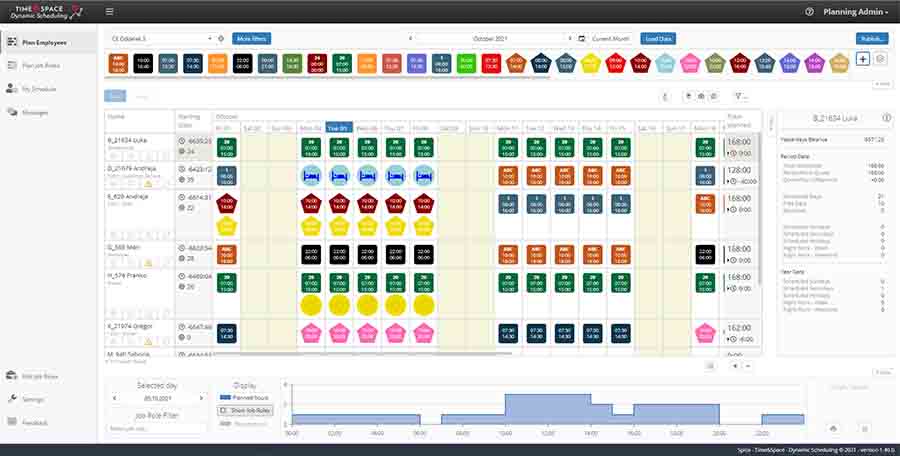How do you plan a multi-shift work that everyone is happy with?


About Big Bang
- Industry: Trade and services
- Founding year: 1991
- Number of employees: 400
- Solutions: Spica Time&Space and DynamicScheduling
- Website: www.bigbang.si
Big Bang’s network of 18 stores and its online hub make it the largest provider of audio-video and computer products on the Slovenian market with market shares between 30% and 60%. In addition to having a leading position on the aforementioned markets, the company is among the largest retailers of household appliances and telecommunication devices.
How did Big Bang reorganise operations to respond to the Covid crisis?
In 2020, a year marked by the Covid-19 pandemic, Big Bang recorded a 14-percent drop in year-on-year sales, which was a result of a prolonged closure of non-essential stores and other epidemic-containing measures. The drop in sales would have been even more significant if the company had not reorganised its operations during the months when the brick-and-mortar stores were closed. On the other hand, online sales in last year reached record values and were 2.5 times larger than online sales in 2019. While the brick-and-mortar shops were closed, all the energy was refocused on internet sales and shortening the time it takes for a product to be supplied from the warehouse to the buyer.
What was implemented:
- A part of the team working in stores has been activated to prepare and ship goods for online customers;
- Contactless takeover points were established for products ordered online;
- A part of the retail team has been activated to assist in back-office services (taking calls from customers, handling complaints, etc);
- The crisis time was used to reorganise the information and product characteristics on the website;
- Big Bang was the first Slovenian retailer to
implement video consulting, where customers can buy desired products “live”.
Challenge: How to plan multi-shift work for 220 employees?
Big Bang employs over 400 sales persons working in 18 stores across Slovenia. The stores are open from morning until evening, from Monday to Saturday, which means that the work is organised in two shifts.
Multi-shift work, weekend work, student work, and the need for high work efficiency already meant that Big Bang, in its role as a retail and service company, needed to keep precise working time records and use advanced access controls, which were handled by the Spica Time&Space solution.
Picture: Dynamic scheduling application is available on mobile or web:

However, one human resource challenge remained. Planning the schedules for over 220 employees was still done manually and using best efforts by the heads of individual business units and their deputies. The multi-shift work therefore required monthly preparation of over 300 schedules, the coordination of which was additionally complicated by unplanned work absences and employees going “on loan” to other company branches.
“Branch managers used an online application to plan the schedules, however its use became complex and slow with an increased number of schedules and exceptions. That is why we were looking for a solution in the form of a special-purpose application, which we found with the help of our technology partner, Spica,” said Dejan Smrdelj, a retail specialist for Big Bang.
Schedule planning on steroids
Spica introduced Big Bang to Dynamic Scheduling – a solution for simple schedule allocation and workforce planning. Now Big Bang can plan its workforce in all its Slovenian branches according to its actual needs, which means that the company was able to optimise labour costs, because the employees work less (unnecessary) overtime. Planning the work using the special-purpose solution is also much faster and error-free, and is compliant with legislative frameworks, because Dynamic Scheduling immediately warns the schedule planner about potential overlaps, working time overruns, and other legal restrictions. At the same time, employee satisfaction is up.
“We immediately saw that the new solution was performing excellently, because both branch managers and employees gave us exclusively positive feedback – as well as because of information visualisation and time saved on schedule planning,” said Timor Kokol, Big Bang's advanced IT project specialist, adding: “Our partner Spica International also surprised us with their responsiveness – all the collected proposals for improvement and adjustment to our environment were implemented at the next application update, which is truly impressive.”
Simple and coordinated schedules that are also suitable for non-standard cases
Big Bang is a company whose workforce needs also have a strong seasonal component, leading to an increased demand for staff in branches, especially for sales and warehouse personnel. The Dynamic Scheduling solution, used by the company to plan employee schedules and absences on a daily, weekly, and monthly basis, turned out to be extremely adaptable, allowing for fast and simple adjustments and harmonisations of schedules on a daily basis for various reasons; the option for employees to go “on loan” to a different unit is especially useful.
“Dynamic Scheduling is not only a fast and graphically sophisticated workforce management solution; it also allows us to plan employee exchanges between units, which is a welcome new addition that was previously not available,” summarised Kokol.
What does the future bring? Further automation and employee productivity measurement
The Dynamic Scheduling solution is also related to other systems within Big Bang, enabling branch managers and the HR department to automatically recalculate employee sales numbers within the planned schedule and work-time records. An employee’s performance is therefore measured using various indicators, which can be monitored by each employee in the sales assistant application.
Soon, schedules will be added to this employee application, so that employees will at any time be able to check their schedule for the day, week, or month, as well as to receive notifications through the application about potential changes – in real time. The employees will also be able to see their productivity in any selected time period and the work they have performed in the planned time.




